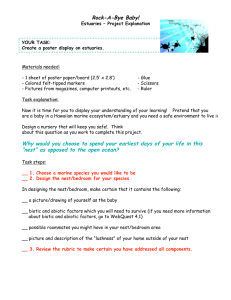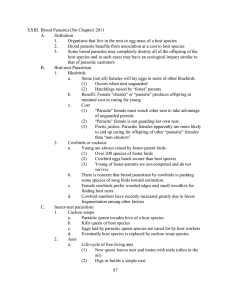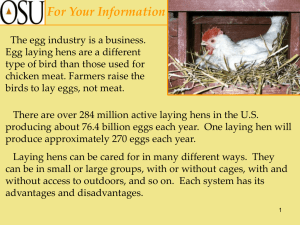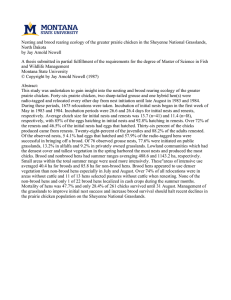HATCHERY/BREEDER TIP ... Cooperative Extension Service The University of Georgia
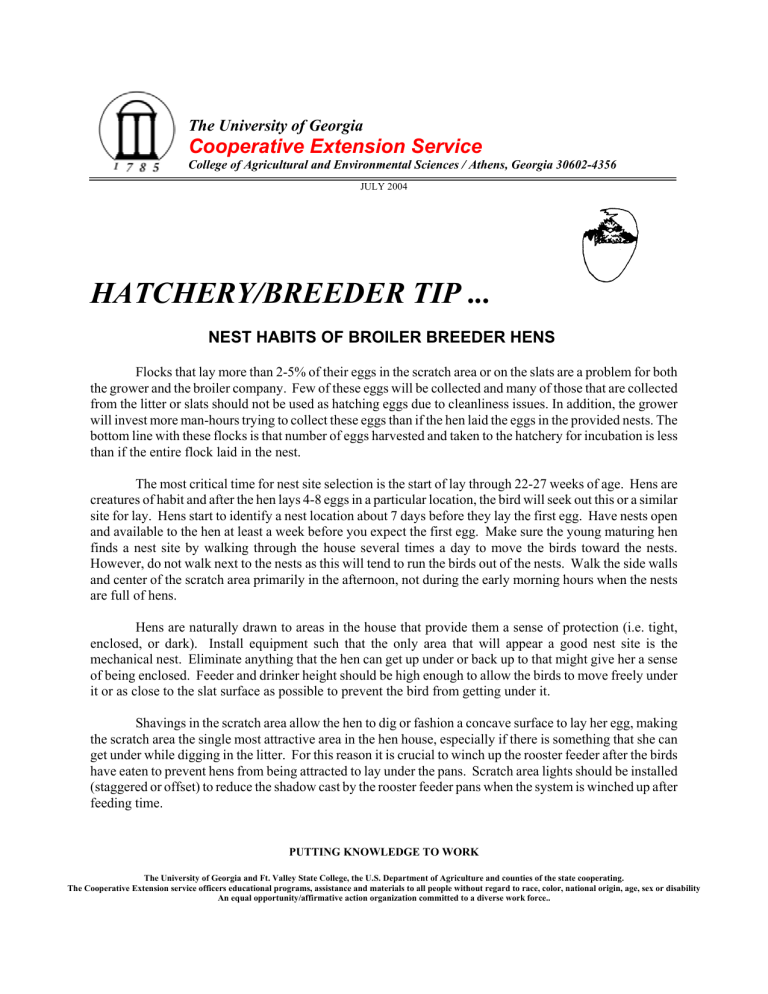
The University of Georgia
Cooperative Extension Service
College of Agricultural and Environmental Sciences / Athens, Georgia 30602-4356
JULY 2004
HATCHERY/BREEDER TIP ...
NEST HABITS OF BROILER BREEDER HENS
Flocks that lay more than 2-5% of their eggs in the scratch area or on the slats are a problem for both the grower and the broiler company. Few of these eggs will be collected and many of those that are collected from the litter or slats should not be used as hatching eggs due to cleanliness issues. In addition, the grower will invest more man-hours trying to collect these eggs than if the hen laid the eggs in the provided nests. The bottom line with these flocks is that number of eggs harvested and taken to the hatchery for incubation is less than if the entire flock laid in the nest.
The most critical time for nest site selection is the start of lay through 22-27 weeks of age. Hens are creatures of habit and after the hen lays 4-8 eggs in a particular location, the bird will seek out this or a similar site for lay. Hens start to identify a nest location about 7 days before they lay the first egg. Have nests open and available to the hen at least a week before you expect the first egg. Make sure the young maturing hen finds a nest site by walking through the house several times a day to move the birds toward the nests.
However, do not walk next to the nests as this will tend to run the birds out of the nests. Walk the side walls and center of the scratch area primarily in the afternoon, not during the early morning hours when the nests are full of hens.
Hens are naturally drawn to areas in the house that provide them a sense of protection (i.e. tight, enclosed, or dark). Install equipment such that the only area that will appear a good nest site is the mechanical nest. Eliminate anything that the hen can get up under or back up to that might give her a sense of being enclosed. Feeder and drinker height should be high enough to allow the birds to move freely under it or as close to the slat surface as possible to prevent the bird from getting under it.
Shavings in the scratch area allow the hen to dig or fashion a concave surface to lay her egg, making the scratch area the single most attractive area in the hen house, especially if there is something that she can get under while digging in the litter. For this reason it is crucial to winch up the rooster feeder after the birds have eaten to prevent hens from being attracted to lay under the pans. Scratch area lights should be installed
(staggered or offset) to reduce the shadow cast by the rooster feeder pans when the system is winched up after feeding time.
PUTTING KNOWLEDGE TO WORK
The University of Georgia and Ft. Valley State College, the U.S. Department of Agriculture and counties of the state cooperating.
The Cooperative Extension service officers educational programs, assistance and materials to all people without regard to race, color, national origin, age, sex or disability
An equal opportunity/affirmative action organization committed to a diverse work force..
The height of the slats or the distance the hen has to jump to access the slats and nests has reduced dramatically. It was not uncommon to have 24-32 inch slat height ten years ago. Many new houses are being built with little (4-8 inch) difference between the scratch area surface and the slats by raising the scratch area or digging out the area under the slats. The meat yielding birds used today are top heavy, more awkward and less able to get on high slats. For reasons of bird health and livability, lowering the slats improves bird access to feed and water. Likewise it easier for the hen to lay in the scratch area than access high slats to get to a nest. Producers with high slats often ask if floor laying could be reduced by building ramps in existing housing to aid the hen in accessing the slats and nests. In limited cases this maybe helpful, but keep in mind that whatever is built should not provide corners or anything for the hen to get under as these areas will attract them as alternative nest sites.
Light distribution should be even over the entire square footage of the house. This is challenging with the high light output of energy saving light sources used in the typical breeder house. Each light source
(lamp) produces more light in a zone around that fixture and thus few fixtures are need. But with fewer fixtures, it is more difficult to get uniform light output to all areas in the house. Go into the breeder house at dawn or dusk (when light from the translucent curtains is at a minimum) and look for dark areas. Also, go in the breeder house at noon on a bright sunny day and determine if there are dark areas (i.e., evaporative cooling pad end of house). Add light fixtures to increase the uniformity the light level. Hens will be drawn to the dark areas as they provide them a sense of being protected. The surfaces (ceiling, sidewall, slat skirt, curtains and slats) inside the house can assist if surfaces are reflective, so when given a choice always select white or light colors for the interior of breeder houses.
Nest size is becoming an issue. The body weight (start and finish weights) of broiler breeders is continuing to increase as broiler weight increases. The nest that worked 20 years ago is not likely to work as well today. Nest manufacturers have increased nest size, lowered front entry areas, and added holes for air movement. Hens won’t use what they cannot easily and comfortable enter.
In 1995 the poultry industry routinely provided 1 mechanical nest for every 5.5 hens and this nest ratio has changed very little. When house design prevents having this ratio of hens per nest, competition for nesting space can encourage hens to seek an alternative site increasing floor and slat laying. Reducing the number of hens placed in a facility to get close to 5.5 hens per nest, reduces competition and floor and slat laying. Obviously, reducing hens placed is not popular with growers, but maybe necessary if adding nests is not possible.
Some strains of hens are less likely to lay in nests and appear to lay anywhere they happen to be.
With these strains, floor and slat egg numbers will be higher, but discouraging this behavior with a proper house design and good management will reduce floor and slat eggs numbers.
Stray voltage can encourage alternative nest site selection by discouraging hens from visiting the nest.
If a farm has a history of floor and slat eggs, the nest systems should be checked for stray voltage. Normally, checking the system once will not be sufficient, as levels of stray voltage come and go depending electricity usage down line from the farm. Check the voltage of the nest system on each side of the house and several times throughout the day. Since nesting habits are more influenced by factors during the first weeks after moving to the laying house, check for stray voltage during this time as season the year can affect stray voltage.
We continue to learn about nesting habits of breeding birds and especially about broiler breeder hens.
If you have additional facts that you would like to share or questions, please email me at jeannaw@uga.edu
.
Jeanna L. Wilson
Extension Poultry Scientist Extension County Coordinator/Agent
**Consult with your poultry company representative before making management changes**
“Your local County Extension Agent is a source of more information on this subject.”





